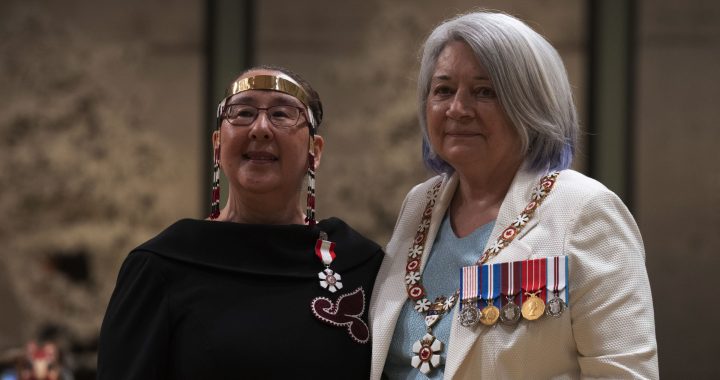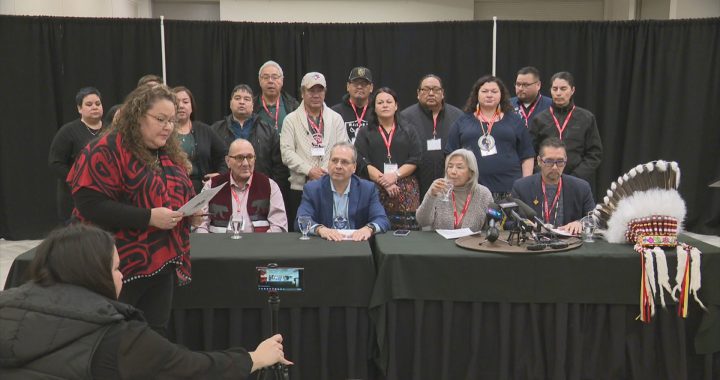APTN National News
OTTAWA–The final word on a proposed open pit gold and copper mine that the Tsilhqot’in British Columbia have vowed to oppose at all cost now rests with Environment Minister Leona Aglukkaq.
Aglukkaq has received a report from the Environment Assessment Agency’s environmental review panel report on Taseko Mines Ltd.’s proposed $1 billion New Prosperity Mine, according to a spokesperson.
The report found the project would have a serious impact on water quality, fish and grizzly bear habitat and impact the Aboriginal rights and title of the Tsilhqot’in and the Secwepemc nations.
The panel has no power to reject the project, which is a federal cabinet decision which will be based on weighing the project`s environmental impacts versus its economic benefit.
Aglukkaq’s spokesperson Amanda Gordon said cabinet would study the issue and the minister would announce the fate of the project in the coming months. The minister has four months to respond to the panel report.
The proposed project is expected to have a 20-year lifespan and sit about 125 kilometres southwest of Williams Lake, B.C.
Former environment minister Jim Prentice already rejected a previous version of Taseko’s proposed mine project in 2010. The previous federal Liberal government also rejected the project in the mid-1990s.
Tsilhqot’in National Government Tribal Chair Joe Alphonse said in a statement that Ottawa needs to put “a nail in the coffin,” and kill the proposed project for good.
“First Nations will be outraged if the federal government accepts this project after rejecting the first one,” said. “This report makes it abundantly clear that the only misinformation being put out about his project is the company’s own claims that it has addressed all the issues and that its proposal will present no problems.”
Taseko, however, said in a statement it disputed some of the report’s findings.
“We strongly disagree with the panel’s findings related to the potential impact on the water quality, fish and fish habitat of Fish Lake. Taseko will challenge these findings as they contradict best practices in place around the world today and expert opinion and analysis,” said the company in the statement. “The report in most respects agrees with our assessment that there would be no significant adverse affects. The risks are modest and the social and economic benefits are enormous.”
The fate of Fish Lake, which is sacred to the Tsilhqot’in, has been at the centre of the battle over the proposed mine.
Taseko’s initial proposal would have drained Fish Lake and turned adjacent Little Fish Lake and part of Fish Creek into tailings ponds, holding waste from the mine. The company plans to construct 7.8 km of earth-rock filled dams that will rise up to 115 metres high.
The 27 square-kilometre mine is being constructed in the Fish Creek watershed which includes Fish Lake and Little Fish Lake. The watershed drains into the Taseko River.
The company’s updated proposal for the mine would still destroy Little Fish Lake, but try to artificially preserve Fish Lake, which will see a reduction in water flow from tributaries.
The panel, however, cast doubt on the company’s plan.
“Taseko underestimated the volume of tailings pore water seepage leaving the tailings storage facility and the impacts on water quality caused by the recirculation of water within Fish Lake and Upper Fish Creek system,” said the panel, in its executive summary. “The panel also determined considerable uncertainty remains regarding Taseko’s contingency plan for water treatment…The panel has determined that the proposed target water quality objectives for Fish Lake are not likely achievable.”
The panel said the project would “result in a significant adverse affect on fish and fish habitat in Fish Lake.”
The panel found that the mine site would bury Tsilhqot’in burial and cremation sites and have an “adverse” impact on Tsilhqot’in and Secwepemc ceremonial and spiritual practices.
“The panel has determined that the project would have adverse affects on the Tsilhqot’in current use of lands and resources for traditional purposes, archeological and historical sites and cultural heritage and that these adverse effects could not be mitigated and therefore would be significant,” the panel said.
The panel determined that the Tsilhqot’in have “proven and asserted” Aboriginal rights on the mine site area, while the Esk’etemc and the Stswecem’c Xgat’tem have asserted Aboriginal rights and title on the transmission line corridor.
“The project would adversely affect established and asserted rights and title for the Tsilhqot’in and Secwepemc Nations,” said the panel.
The panel found that the mine project is also expected to have a negative impact on the south Chilcotin grizzly bear population, which is listed as “threatened” by the B.C. government.
“If (Taseko’s) mitigation measures proposed by Taseko were effectively implemented, the South Chilcotin grizzly bear population would babe in better shape after the project than before the project, however, effectively implementing these measures could be challenging.”
Taskeo says the project would create 550 direct jobs and 1,280 indirect jobs along with pumping $26.2 million annually into government coffers during construction and $48 million annually during operations.










